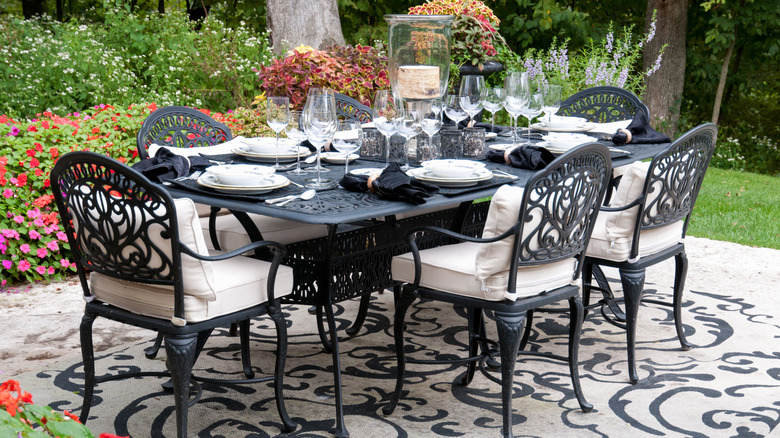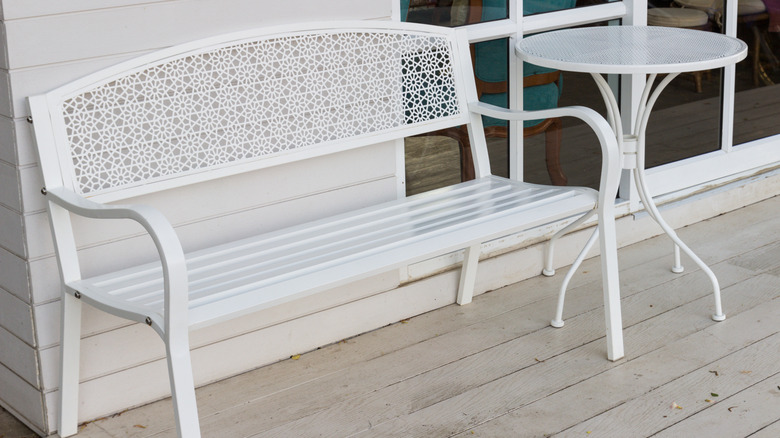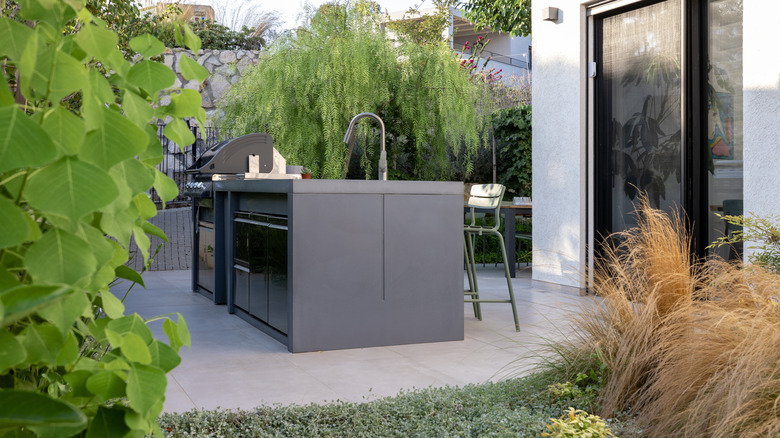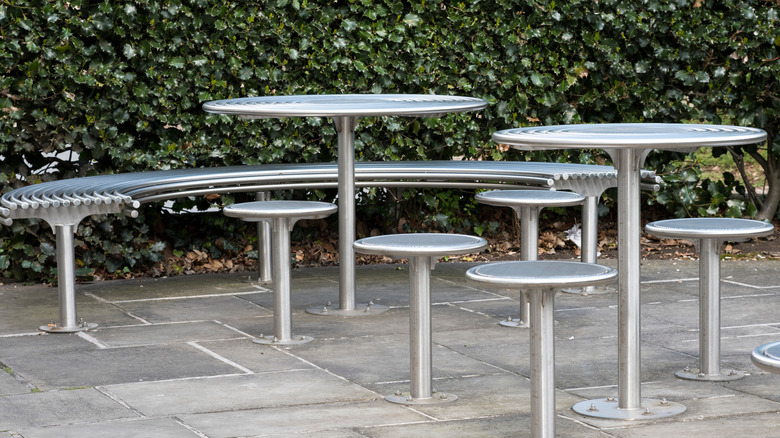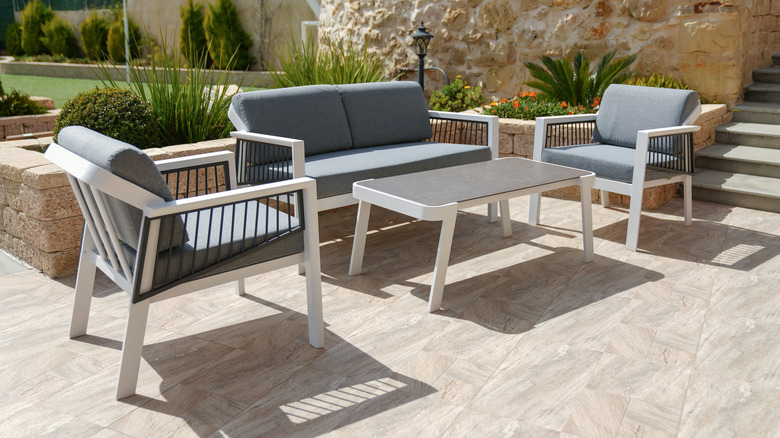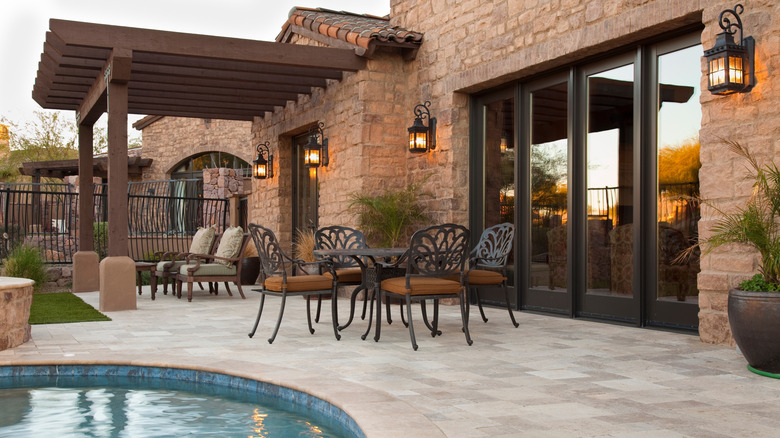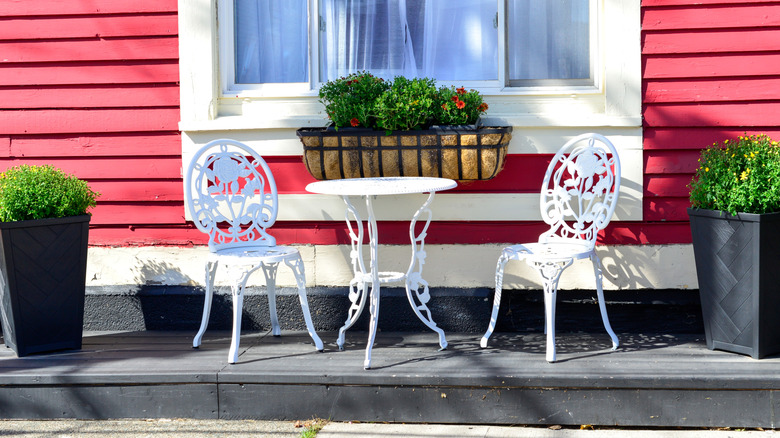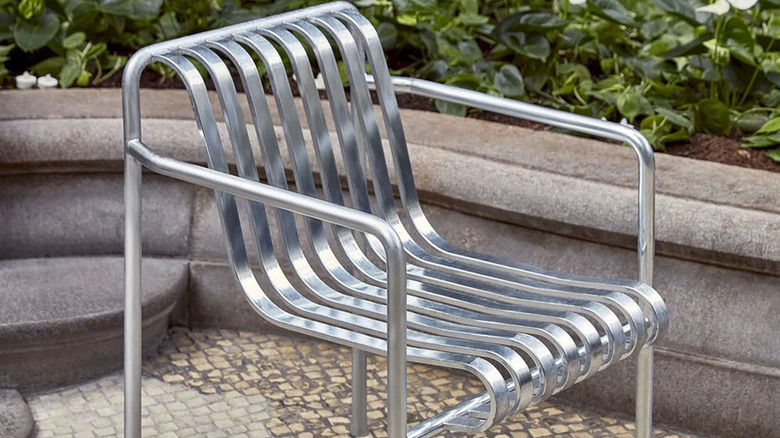The Best Way To Clean All Your Metal Outdoor Furniture
We may receive a commission on purchases made from links.
Once spring temperatures begin to rise, the desire to spend time outdoors increases right along with it. Taking the time to clean your metal garden furniture is the best way to create a welcoming environment for relaxing with family or hosting a few friends for a meal. When it comes to metal furniture, such as aluminum, wrought iron, stainless steel, or chrome, there is no one-size-fits-all cleaning method. While these materials are chosen for their strength and durability, they still need to be cared for properly in order to prevent rust from forming and to keep protective finishes from becoming dull.
It's just as important to know which outdoor furniture cleaning mistakes to avoid. Using abrasive scrubbers or harsh chemicals might seem like a quick option for dealing with stuck-on dirt and grime, but they can scratch powder-coated metals, strip protective paint, or even remove the zinc coating from galvanized steel. Once this happens, the metal becomes vulnerable to rust, especially if the furniture is kept in an uncovered area in your backyard. By using the right tools and cleaners for each type of metal, you not only keep the furniture looking like new, but you'll also extend its life as well.
Take care with powder-coated metals
Not only are powder-coated metal garden furniture pieces durable, but they also come in a wide variety of colors. The coating helps protect the underlying aluminum or steel from becoming damaged by summer weather, adding to its overall purchase appeal. If you have a powder-coated patio set, lounger, bench or plant stand, you'll want to keep it clean by first loosening any dirt with a damp cloth. Stubborn dirt and debris can be removed using a soft-bristled brush or a pressure washer that uses filtered water and is turned to the lowest pressure setting. Unfiltered water isn't recommended since it may stain your finish, due to elements like chlorine, sulfur, and fluoride. Use a mild dish soap and water solution to fully clean each powder-coated item before rinsing the metal and drying it with a microfiber towel. A generic car wax with a UV inhibitor can be applied after the furniture has been thoroughly cleaned to add another layer of protection from constant sun exposure — just avoid compound waxes.
What you shouldn't do when cleaning powder-coated outdoor furniture is just as important as what you should. Avoid using abrasive scrubbers, such as steel wool or scratchy sponges, as these can nick and dull the powder-coated surface. Harsh chemical cleaners, organic solvents, or acidic and alkaline-based solutions can degrade the coating over time, making it brittle and prone to peeling, as well as leave it susceptible to rain and sun damage. High-pressure washers may seem like a great way to get the task done quickly, however, they can force water under the coating, as well as chip away the finish. These types of damage compromise the protective barrier, leaving the metal underneath exposed to rust and corrosion formation.
Go with the grain when cleaning stainless steel
Stainless steel outdoor furniture is prized for its polished, modern appearance and high resistance to rust and corrosion, making it a popular choice for dining tables, chairs, benches, and accent pieces in contemporary outdoor spaces. To keep it shiny and the focal point of your patio, you'll want to clean stainless steel furniture properly. Start by wiping down the surface with a microfiber cloth to remove loose debris. Then, use a soft-bristle brush with mild dish soap, or a stainless steel-specific cleaner, gently scrubbing with the grain of the metal. Be sure to dry the surface of the furniture completely with a soft towel before moving on to your next project. For added shine, you can apply a stainless steel polish after cleaning. Good Housekeeping revealed that experts rate Magic Stainless Steel Cleaner & Polish as the best choice for this job, as it works quickly to remove stains and doesn't leave behind any pesky streaks.
When cleaning stainless steel, never use abrasive materials or steel wool pads to lift away dirt and grime. These items may scratch the surface, leaving it more vulnerable to future rust. It's also important not to scrub against the grain of the metal, as this can create visible marks that are difficult to remove. Harsh chemicals like bleach or ammonia should be avoided, as they can damage the protective finish and accelerate discoloration or corrosion over time. Lastly, never allow stainless steel to air dry. This results in unsightly water spots, which take away from the shine stainless steel is so commonly known for.
Stick with distilled water when washing chrome
Known for its shiny, high gloss finish and sleek, modern style, chrome outdoor furniture is often found in accent chairs, café tables, as well as in decorative framing on mixed-material pieces. To clean chrome effectively, start by mixing a small amount of a gentle dish soap with warm water. If you have hard water, it is recommended that you stick with distilled water when cleaning chrome. Grab a soft microfiber sponge and carefully wipe away all the dirt and grime. For tougher spots or surface rust, you can use a toothbrush dipped in baking soda or gently rub the area with a crumpled piece of aluminum foil that has been dipped in a soapy water solution. This works well without scratching the finish. Once clean, rinse with water and immediately dry the furniture with a soft cloth to prevent water spots. To restore shine and protect the surface, apply a chrome-safe polish like Brasso Multi-Purpose Metal Polish using a clean, dry cloth.
Avoid using abrasive cleaners, stiff-bristled brushes, or scouring pads on chrome, as they can easily scratch the delicate surface and dull its reflective finish. It's also important not to leave chrome wet after cleaning or exposure to rain, as moisture can collect around joints and crevices, causing rust to form even on this corrosion-resistant metal. Stay away from any cleaners that aren't specifically labeled as safe for chrome, including bleach, ammonia, or industrial degreasers, as these can strip away protective coatings and accelerate damage. Gentle, routine care is key to keeping chrome furniture bright, rust-free, and looking like new.
Use a soft-bristled brush with aluminum
Aluminum outdoor furniture is a popular choice for patios and garden spaces, thanks to its lightweight design, rust resistance, and modern appearance. You'll often find it used in lounge chairs, dining sets, side tables, and stackable seating. The best way to clean aluminum is simply to wipe the piece down with a damp cloth and then use a mild detergent mixed with water and a soft-bristled brush to fully remove dirt and debris. For added protection and shine, a light coat of automotive wax or aluminum polish can be applied after cleaning. Just make sure to buff off any excess wax. If the furniture is plagued with oxidation, a vinegar and water solution can help dissolve it. Unlike other metals, aluminum furniture can safely be left to air dry.
There are some important precautions to take when cleaning aluminum. For starters, you'll need to avoid harsh commercial cleaners, especially on anodized aluminum, as they can strip the finish or cause discoloration. Hard-bristled brushes can scratch the surface, so stick to soft-bristle tools unless you're smoothing rough spots with fine steel wool before cleaning. While pressure washers can be used carefully, their force can easily tip or damage lightweight aluminum furniture if not handled properly. Place the machine on the lowest pressure setting possible before you begin. Using abrasive methods may compromise the protective oxide layer that naturally forms on aluminum, shortening the life and appearance of your furniture. Gentle, routine maintenance is the key to preserving its good looks and structural integrity.
Let wrought iron furniture air dry
Wrought iron outdoor furniture is known for its elegant, vintage-inspired designs and sturdy construction, often found in garden benches, bistro sets, patio dining chairs, and ornate accent tables. To successfully clean wrought iron furniture, start by wiping the piece with a damp cloth to remove surface dust and debris. Then use a mild soapy water solution and a soft-bristled brush for a more thorough clean. An old toothbrush works well for getting into decorative curves and crevices. After rinsing, the furniture can be left to air dry. To protect the surface and enhance its longevity, apply a light coat of automotive spray wax or even a mineral oil. If any bare metal or chipped paint is visible, touch it up with a rust-resistant metal primer, and finish with matching paint.
When caring for wrought iron, it's crucial not to ignore areas affected by rust, as these can spread and weaken the metal over time. Use steel wool or an 80-120 grit sandpaper to remove rust spots and rough patches, applying only as much pressure as is needed to smooth the targeted area. Once the rust is removed, always prime and repaint the exposed metal to prevent future corrosion. Avoid harsh chemical cleaners or overly abrasive tools on intact areas, as these can damage the finish and invite rust. With routine care and timely touch-ups, wrought iron furniture can remain a beautiful and long-lasting addition to your outdoor space.
Grab vinegar when cleaning cast iron
Cast iron furniture has a substantial weight to it, making it an excellent choice for outdoor pieces, such as garden benches, charming bistro sets, and decorative table bases. To clean cast iron, begin by gently scrubbing away any rust with a wire brush. A coarse grit sandpaper can also be used to remove and smooth out rust spots. Next, mix a solution of either a mild dish soap and water, or white distilled vinegar and water. Use a sponge to wash the surface, moving in a circular motion to effectively lift away dirt and buildup. Rinse thoroughly with a garden hose to remove any remaining residue and allow the furniture to air dry in the sun. After cleaning, you can apply a clear sealant, as well as a rust-resistant paint to prevent future damage.
When cleaning cast iron, it's important to avoid overly aggressive tools or harsh chemical products. Mechanical tools, such as power grinders or sanders, can damage the metal's integrity or fine details, especially on antique or decorative pieces. Similarly, antibacterial soaps and cleaners that contain bleach should be avoided, as they can be too abrasive and may lead to corrosion or discoloration down the line. While cleaning cast iron may seem like a tedious task, taking the time to care for the furniture properly will ensure your family and friends continue to enjoy each piece for years to come.
Wash zinc-coated furniture with a mild detergent
Zinc-coated outdoor furniture is also commonly referred to as galvanized steel. The steel is outfitted with a protective zinc layer to better resist rust and corrosion, while offering a sleek, industrial look. This type of furniture is commonly seen in patio dining sets, garden benches, and industrial-style tables. It's also used as a base for various pieces, like patio sectionals. The best way to clean zinc is to mix a mild detergent or pH-neutral cleaner with warm water and use a soft cloth or sponge to gently wipe down the surface. Be sure to rinse away all traces of soap residue, as experts warn this makes the zinc-coating more susceptible to corrosion. After drying, apply a clear sealant or protective wax to help preserve the zinc coating and guard against the elements.
To keep zinc-coated furniture in top condition, avoid using abrasive tools like steel wool, scouring pads, or hard-bristle brushes, as these can scratch or wear through the protective zinc layer, which leaves the underlying steel exposed and subject to rust formation. Additionally, it is imperative that you forgo the use of any acidic or alkaline cleaning products, as they can chemically alter the zinc, allowing corrosion to occur much sooner than it would otherwise. It is important to note that using the wrong cleaner or tool may not show immediate damage, but over time it can significantly shorten the lifespan of your furniture. Gentle, non-reactive cleaning methods are essential to maintaining both the clean look and longevity of zinc-coated pieces.
